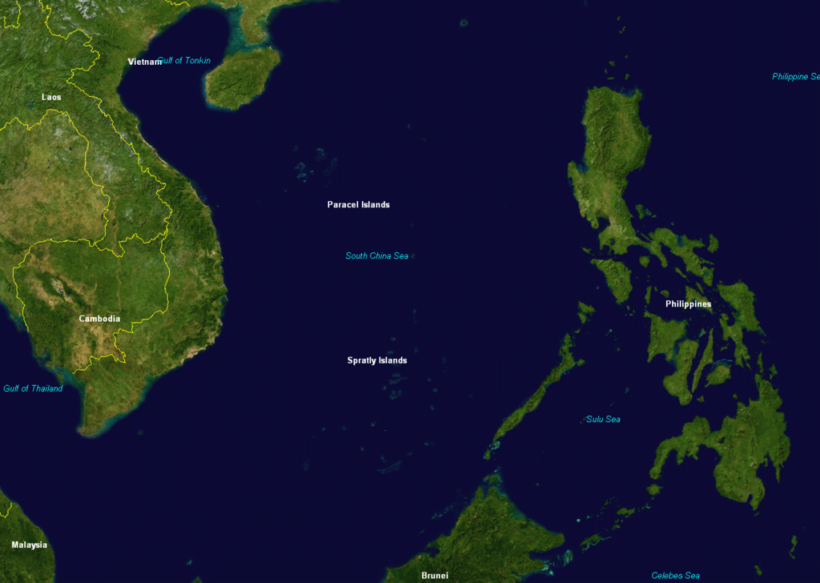By Perfecto Caparas
To this day, Beijing’s People’s Liberation Army Navy continues to illegally bar Manila from accessing geologic features in Spratly Islands, even though they fall within the Philippines’ 200-nautical mile exclusive economic zone (EEZ).
Beijing’s actions violate the law of the sea and the landmark award rendered by the Ad Hoc Arbitral Tribunal constituted under Annex VII of the 1982 UN Convention on the Law of the Sea (UNCLOS) on 12 July 2016. The Hague – in its legally binding award in the Matter of the South China Sea Arbitration case – dealt China’s bogus nine-dash line claim a lethal blow. It ruled:
“China’s claims to historic rights, or other sovereign rights or jurisdiction, with respect to the maritime areas of the South China Sea encompassed by the relevant part of the ‘nine-dash line’ are contrary to the Convention and without lawful effect to the extent that they exceed the geographic and substantive limits of China’s maritime entitlements under the Convention”.
7 Chinese-held features in Spratly Islands
In his article South China Sea: Who Occupies What in the Spratlys?, Alexander L. Vuving identifies the following features in Spratly Islands as being occupied by Beijing:
- Subi Reef (Chinese: 渚碧礁 Zhubi Jiao);
- Gaven Reef (南薰礁 Nanxun Jiao);
- Hughes Reef (东门礁 Dongmen Jiao);
- Johnson South Reef (赤瓜礁 Chigua Jiao);
- Fiery Cross Reef (永暑礁 Yongshu Jiao);
- Cuarteron Reef (华阳礁 Huayang Jiao); and
- Mischief Reef (美济礁 Meiji Jiao).
4 Chinese-occupied reefs in Philippine EEZ
Parts of the Philippine EEZ that are completely and effectively controlled by China include:
- Mischief Reef (Meiji Jiao (美济礁)); Panganiban);
- Johnson Reef (Chigua Jiao (赤瓜礁); Johnson Reef South; Mabini);
- McKennan Reef (Ximen Jiao (西门礁); together with Hughes Reef, known as Chigua Reef); and
- Hughes Reef (Dongmen Jiao (东门礁); together with McKennan Reef known as Chigua Reef).
The arbitral award, however, clearly shows that all these geologic features that China usurps and illegally occupies – Mischief Reef, Johnson Reef, McKennan Reef, and Hughes Reef – lie within the Philippines’ 200-nm EEZ.
Johnson Reef
According to the award’s factual background section, Johnson Reef “is located… 184.7 nautical miles from the archipelagic baseline of the Philippine island of Palawan”. Thus, it is clearly within the Philippines’ 200-nm EEZ.
In contrast, the tribunal notes, Johnson Reef nests “570.8 nautical miles from China’s baseline point 39 (Dongzhou (2)) adjacent to Hainan.”
McKennan Reef
The award also points out that McKennan Reef “is located… 181.3 nautical miles from the archipelagic baseline of the Philippine island of Palawan”. Clearly, it’s also within the Philippine EEZ.
On the other hand, McKennan Reef sits “566.8 nautical miles from China’s baseline point 39 (Dongzhou (2)) adjacent to Hainan.”
Hughes Reef
Further, the award states, Hughes Reef “is located… 180.3 nautical miles from the archipelagic baseline of the Philippine island of Palawan”. Again, it’s situated within the Philippines’ 200-nm EEZ.
Hughes Reef, for its part, rests “567.2 nautical miles from China’s baseline point 39 (Dongzhou (2)) adjacent to Hainan”.
Mischief Reef
The award avers that “Mischief Reef “is located… 125.4 nautical miles from the archipelagic baseline of the Philippine island of Palawan”.
As far as China is concerned, however, Mischief Reef sprawls “598.1 nautical miles from China’s baseline point 39 (Dongzhou (2)) adjacent to Hainan.”
Clearly, therefore, Beijing has been stealing Manila’s maritime wealth abounding in the latter’s 200-nm EEZ.
Ruling on Mischief Reef
As the five-member tribunal declares: “Mischief Reef and Second Thomas Shoal form part of the exclusive economic zone and continental shelf of the Philippines.”
“Mischief Reef, therefore, can only constitute part of the exclusive economic zone and continental shelf of the Philippines,” the tribunal says.
It further asserts: “China’s actions at Mischief Reef have unlawfully interfered with the Philippines’ enjoyment of its sovereign rights.”
And with finality, the tribunal rules: “China has, through its construction of installations and artificial islands at Mischief Reef without the authorization of the Philippines, breached Articles 60 and 80 of the Convention with respect to the Philippines’ sovereign rights in its exclusive economic zone and continental shelf.”
Direct and indirect adverse impact
Based on this award and UNCLOS, Manila must now demand economic compensation from China. This, specifically for the latter’s unauthorized and illegal appropriation for itself of Mischief Reef and the Philippines’ EEZ covering its adjoining maritime areas. These include all the living and non-living resources found in the water column, seabed, and subsoil.
Manila must assert that Beijing compensates the Philippines insofar as Chinese occupation of 7 maritime features in Spratly Islands which adversely impacts and negates – directly and indirectly – the exercise of Philippine sovereign rights and jurisdiction over its own EEZ, especially its access and enjoyment of all its maritime resources adversely impacted by China’s exclusive and absolute occupation and, control of those reefs.
More than five years have already passed since the arbitral tribunal adjudged, with finality, that China’s nine-dash line is“contrary” to UNCLOS and “without lawful effect”. But, until now, China has yet to honor and fulfill its international legal obligations arising from UNCLOS and The Hague’s legally binding award.
 About Perfecto Caparas. Writes a column for Pinoy Publiko. He served as a journalist of Ang Pahayagang Malaya, The Manila Times, The Philippine Post, Pinoy Gazette, UCANews and ISYU Newsmagazine. He is a licensed attorney and lifetime member of the Integrated Bar of the Philippines.
About Perfecto Caparas. Writes a column for Pinoy Publiko. He served as a journalist of Ang Pahayagang Malaya, The Manila Times, The Philippine Post, Pinoy Gazette, UCANews and ISYU Newsmagazine. He is a licensed attorney and lifetime member of the Integrated Bar of the Philippines.










